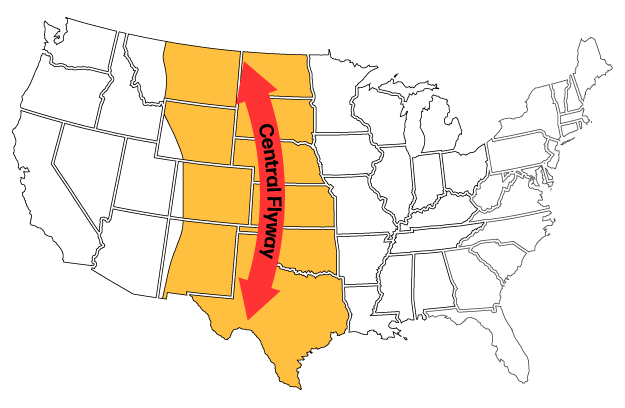In the winter and spring, some 400 bird species journey through the Central Flyway. If you live within this bird migration route spanning the Rocky Mountain region in the Western U.S., there’s ample opportunity to view new species of shorebirds and songbirds alike.
Various features along the Central Flyway provide the food, water, and cover traveling birds seek. There are pockets of wetlands and marshes, along with Utah’s Great Salt Lake, the Colorado River Basin, and plenty of sagebrush and grasslands. Meanwhile, the Rocky Mountains' north-south alignment provides a directional guidepost as the flow of birds moves along either side of the range.
Where is the Central Flyway?
To the east, the Central Flyway covers the High Plains, the area of the Great Plains that leads to the foothills of the Rocky Mountains. West of the mountain range, it spans the Continental Divide, stopping short at the borders of the Pacific Coast states.

Which states are in the Central Flyway?
The Central Flyway covers an impressively large landmass, covering 14 states in the western U.S. region, and the southwestern U.S. It extends through Central America down to South America, and northward to northern Canada, near the Arctic Circle.
- Arizona
- Colorado
- Idaho
- Kansas
- Montana
- Nebraska
- Nevada
- New Mexico
- North Dakota
- Oklahoma
- South Dakota
- Texas
- Utah
- Wyoming

Male Black-headed Grosbeak | Bird Images / iStock / via Getty Images
6 noteworthy birds traveling the Central Flyway
- Black-headed Grosbeak: This bird is often the victim of mistaken identity with the lookalike oriole. Their warbling robin-like spring song rings through conifer forests.
- Bobolink: This little black-and-white songbird with the buff-colored pouf of head feathers is quite the globetrotter. Its migration covers some 12,500 miles from the southern area of South America to the central U.S. for the breeding season.
- Painted Bunting: Your first sighting of a Painted Punting will make you say, “Wow!” because its parrot-like colors — red, blue, green, and yellow — are nothing like those of the other birds. If you live in Texas and Oklahoma, keep your eyes peeled for their summer return.
- Purple Martin: Backyard birders welcome these purplish birds with specially made martin condos — an elevated shelter with multiple openings for martins.
- Western Meadowlark: Their glorious trilling song provides the perfect soundtrack for those gorgeous summer mornings! It’s no wonder that six western states, Kansas, Montana, Nebraska, North Dakota, Oregon, and Wyoming, have adopted the Western Meadowlark as the state bird.
- Western Tanager: With fiery golds, oranges, and a dash of red, its plumage rivals those famous western sunsets.
Songbirds to watch for along the Central Flyway
- American Redstart
- Blue Grosbeak
- Cedar Waxwing
- Golden-cheeked Warbler
- Gray Catbird
- House Wren
- Indigo Bunting
- Lazuli Bunting
- Rose-breasted Grosbeak
- Ruby-crowned Kinglet
- Ruby-throated Hummingbird
- Scarlet Tanager
- Western Meadowlark
- Wood Thrush
- Yellow-bellied Flycatcher
- Yellow Warbler
What to feed birds traveling the Central Flyway
Migrating songbirds will also flock to developed areas, especially when they offer a quick snack and a place to rest. As the seasons shift, it’s a particularly good time to make your yard an oasis by providing food and water.
Welcome your feathered friends with a high-quality mix that doesn’t skimp on the good stuff. Lyric Supreme Mix is chock full of sunflower seeds and nuts to fuel their energy break. Pick up a bag today!
